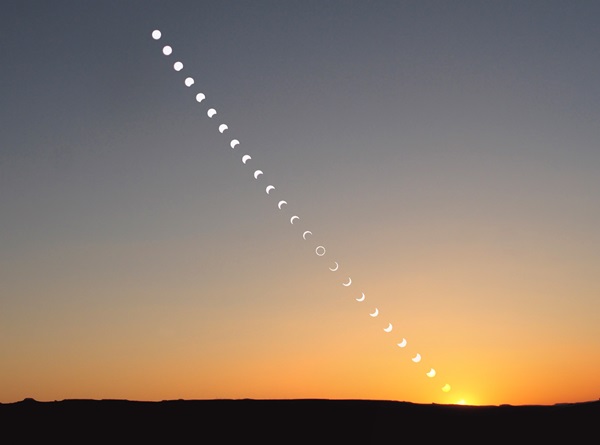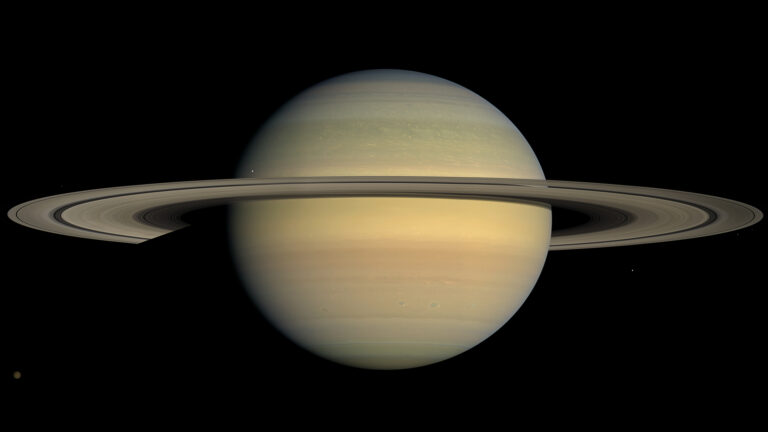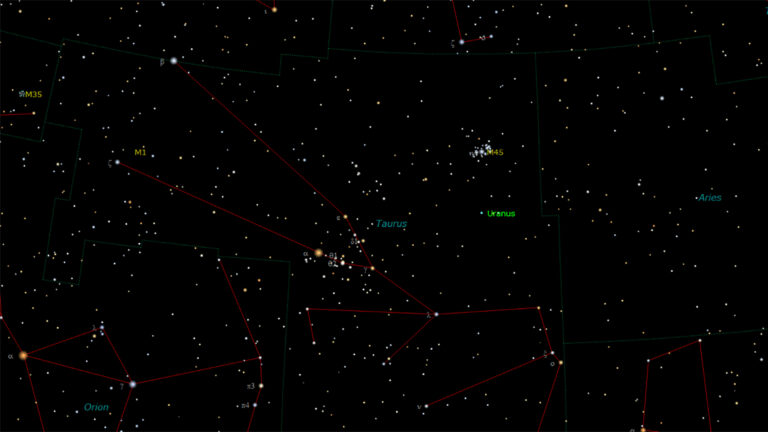Key Takeaways:
As with all near-total eclipses, an observer on the center line away from the midpoint experiences a longer annular phase because the Moon lies slightly farther away and thus appears a bit smaller. The path of this eclipse also crosses a few countries that the State Department considers less-than-totally safe. Visit www.travel.state.gov for the latest information.
Eclipse details
The Moon’s antumbra first touches Earth at 4h47m46s UT at longitude 17°47’50” East and latitude 1°16’06” North. It remains in contact with Earth’s surface for 3 hours 44 minutes 34 seconds, until 8h32m20s UT, when it vanishes at longitude 147°35’14” East and latitude 11°28’20” North. This eclipse has a magnitude of 0.9940 — meaning that, at maximum, the Moon will cover 99.4 percent of the Sun’s diameter.
During the eclipse, brilliant Venus will lie 25° west of the Sun. Shining at magnitude –4.5, this planet may become visible up to 10 minutes before annularity, if your location places it high enough in the sky.
The only other nearby planet will be Mercury, which lies a bit more than 14° east of the Sun. Unfortunately, at magnitude 3.0, our solar system’s innermost world is too faint to be visible.
Crossing Africa’s heart
In 2020, 13 countries will experience the annular eclipse. It starts at sunrise in the Republic of Congo, just east of the city of Epena. And although some people may choose to view the event from this country, the Moon’s antumbra doesn’t stay in the Republic of Congo for long. The entire center line path through the country is only slightly more than 12.5 miles (20 kilometers).
The annular eclipse moves next into Congo, where it begins just south of the town of Buburu at 4h47m46s UT. After a 630-mile-long (1,015 km) trip to the east-northeast, it exits the country at 4h50m04s UT, moving into the Central African Republic just southwest of Obo. The length of the path along the center line in this country is about 75 miles (120 km).
The center line of the Moon’s antumbra leaves the Central African Republic and first touches the next country, South Sudan, at 4h49m50s UT, some 12 miles (20 km) west of the city of Tambura. The roughly 10,000 residents there will experience 1 minute 4 seconds of annularity.
At the border of Ethiopia, the annular eclipse starts at 4h54m24s UT. This country boasts the first truly large city near the path of annularity: Addis Ababa, Ethiopia’s capital and home to some 3.4 million people, lies only 155 miles (250 km) outside the path. Those who remain in the city — and use proper eye protection — will see the Moon cover about 92 percent of the Sun.
As the Moon’s antumbra begins its trek through Ethiopia, a small triangular section of the southeastern part of the Sudan south of the village of El Fil also will experience the annular eclipse. Anyone at the southernmost point of Sudan’s border will witness 54 seconds of annularity with the Sun 20° above the horizon.
At the border of Ethiopia and Eritrea, annularity lasts for 1 minute 7 seconds. The annular phase ends at the coastline of the Red Sea at 5h04m42s UT.
Traversing the Middle East
While over that body of water, the Moon’s antumbra covers Jabal Zuqar, the largest of the Hanish Islands, which are part of Yemen. Annularity at the northern edge of the island lasts 1 minute 2 seconds, while the southern end lies at the edge of the annular path. An observer there — and anywhere along either edge of annularity — will see a lengthy display of Baily’s beads.
The partial phase of the eclipse begins in Yemen at the Red Sea coast at 3h54m51s UT, 22 miles (35 km) southwest of Bayt al-Faqīh. That town will experience 1 minute 5 seconds of annularity. But the place with the easiest access is the capital city of Sana’a, which has 4 million inhabitants and lies only 19 miles (30 km) northwest of the center line. A quick trip to the Khawlan District will yield 1 minute 4 seconds under the Moon’s antumbra.
As the eclipse progresses through Yemen, the northern extent of the antumbra encounters a tiny part of Saudi Arabia south and east of the border town of Al Wadiah. Although this strip is barely 30 miles (50 km) long, Saudi residents who position themselves on the road at the border crossing could experience up to 37 seconds of annularity.
The eclipse begins in Oman in a desert region devoid of cities or even small towns. Climate data points to extremely hot, dry days, with the average cloud cover below 5 percent. The country’s capital, Muscat, a city of 1.7 million, lies northwest of the path of annularity. Even so, the residents there will enjoy near-umbral darkness as the Moon covers 98 percent of the Sun’s disk. Venus should stand out well at mideclipse.
Spanning southern Asia
After the antumbra spends 10 minutes 51 seconds traversing the Gulf of Oman, it enters Pakistan southeast of the small town of Kappar. The eclipse path through this country of some 200 million people stretches some 675 miles (1,085 km).
At 6h17m48s UT, annularity begins in India only a few miles northwest of the town of Gharsana. Unfortunately, most of the country’s 1.3 billion people live south of the path. That said, the northern edges of the capital city, New Delhi, with its metro area of some 26 million residents, lies within 62 miles (100 km) of the center line. Travelers taking Highway 44 to a point just north of Kurukshetra will experience 38 seconds of annularity.
After mideclipse, the center line tracks through only 30 miles (50 km) more of India before moving into Tibet (China). Travelers wishing to view the eclipse from this region should prepare for mountainous terrain. The easiest route to the center line is by driving about 155 miles (250 km) north of the largest city in the Tibet Autonomous Region, Lhasa, along Highway G109. The same location can be reached by driving south from Nagqu along the same road. There, the event will last 40 seconds with the Sun 71° above the horizon. The best weather prospects in Tibet are for locations near Lake Manasarovar, which sits 15,060 feet (4,590 meters) above sea level.
Although China, with its lengthy eclipse track and many wonderful sights, seems like an ideal place for eclipse watchers, weather prospects are not good. Due to the monsoon season, average cloud cover over much of eastern China ranges from 70 to 90 percent at this time of year.
As the eclipse’s path leaves China, it crosses the South China Sea at the Taiwan Strait and touches the northern part of the Penghu Islands. On the northernmost island, an observer will experience 59 seconds of annularity.
When the center line hits the Taiwanese coast just west of Chiayi City at 8h13m17s UT, observers will witness a one-minute annular eclipse. The antumbra makes its last landfall on the island’s east coast at 8h15m58s UT. Unfortunately, with the potential for cloudiness at 94 percent, Taiwan offers the worst weather prospects for eclipse viewers.
Into the Pacific Ocean
After leaving Taiwan, the Moon’s antumbra continues for another 1,900 miles (3,055 km) over the open waters of the Pacific Ocean. The closest it gets to land again occurs less than 230 miles (370 km) from the end of the antumbral path, where the southern tip of Guam lies a scant 8 miles (13 km) from its northern limit. Closest approach is at 8h31m14s UT with the Sun only 3° above the horizon. The eclipse officially ends at sunset at 8h32m20s UT.
Iffy weather prospects along much of the path and some less-than-welcoming countries would daunt most travelers. Eclipse chasers, however, are a different breed. Their desire to see the “ring of fire” simply makes the June 21 annular eclipse another of life’s great adventures.
















